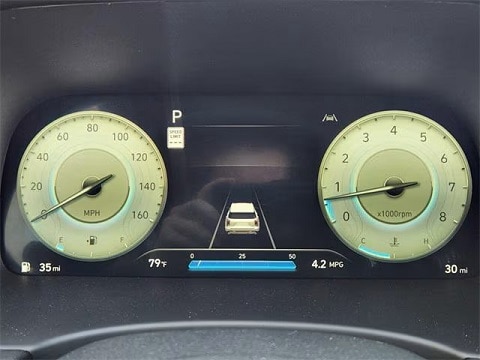
Important Fluids and Levels To Check
Regularly maintaining your Hyundai lets you discover issues before they become serious and keeps your vehicle running at optimal performance. Some of the key fluids you should check include:
- Engine oil: Engine oil is essential for lubricating engine parts. Check the oil level regularly and change it as recommended to keep it clean.
- Coolant: Coolant helps to maintain the engine temperature. Top up the coolant tank to the required level to stop your vehicle from overheating.
- Brake fluid: Topping off your brake fluid keeps your braking efficient. Any drop in its level might signal a leak or worn brake pads.
- Power steering fluid: This fluid is critical for smooth steering. Low levels can make steering difficult, so ensure that you always keep it at the proper level.
- Transmission fluid: The transmission fluid lubricates gearbox components. Low or degraded fluid can affect gear shifting.
- Windshield washer fluid: This fluid cleans your windshield and is essential for clear visibility. Refill it as needed, especially before long drives.
- Battery electrolyte level: For non-sealed batteries, maintain the electrolyte level to ensure battery efficiency.
Hyundai Dashboard Warning Symbols
Dashboard warning symbols tell you if your vehicle is operating well and signify if your vehicle needs servicing or repair soon. Depending on the warning, the icons light up red, yellow/orange, or green/blue. Here's a breakdown of the symbols and what they mean:
Critical Warning Symbols (Red)
Red symbols often signify that your vehicle needs immediate attention.
- Engine oil pressure warning: This warning indicates low oil pressure in your car. When you see it, stop your vehicle and check the oil level immediately.
- Battery charge warning: There's a battery charging issue or possibly an alternator failure.
- Seat belt warning: The seat belt warning usually flashes when you or your passengers have not fastened your seat belts.
- Parking brake and brake fluid warning: The parking brake is engaged, or there's a drop in brake fluid level.
- Airbag warning: There's a fault in the airbag system that needs immediate attention.
- High engine temperature warning: The engine temperature is too high, so stop your vehicle and let your engine cool.
Important Warning Symbols (Yellow/Orange)
Yellow or orange symbols usually mean your vehicle may soon need repairs or services. Here are some common ones:
- Check engine light: This indicates general engine issues, so bring your vehicle in for a diagnostic scan.
- Anti-lock brake system (ABS) warning: The ABS is malfunctioning, affecting brake efficiency. It's important to take your vehicle to a repair shop as soon as possible if you see this symbol.
- Electronic stability control warning: There's a problem with the stability control system, which may be dangerous on the road.
- Tire pressure monitoring system warning: Low tire pressure can cause driving issues. Check your tires and adjust as needed.
- Low fuel warning: The fuel level is low, and it's time to refill your gas tank.
Informational Symbols (Green/Blue)
Green and blue symbols are operational indicators that let you know if something is switched on:
- Cruise control indicator: Cruise control is on, letting you cruise on highways and longer roads.
- High beam indicator: High beam headlights are on, usually used when driving at night or in the rain.
- Turn signal indicators: Turn indicators let you signal to other drivers which way you're turning.
- Door ajar indicator: One or more doors are open, so you check your doors to make sure they're all properly shut.
Importance of Regular Maintenance
Routine maintenance of your Hyundai can prevent many of the issues that dashboard symbols indicate. Regular services such as oil changes, brake inspections, and fluid top-ups can keep your vehicle in shape and avoid unexpected warnings. Consider visiting the Huffines Hyundai Plano's service department for professional maintenance services whenever you notice any red or yellow symbols on your dashboard.
What To Do When You See a Warning Light
Encountering a warning light can be unsettling, but following these steps can mitigate risks:
- Refer to your Hyundai's owner's manual for guidance on the specific symbol, if you're not sure what it means.
- Identify whether your vehicle requires immediate attention or if you need to contact the dealership for a service appointment.
- Schedule a visit to a certified Hyundai service center to solve more complex issues.
Ignoring dashboard warnings can lead to reduced vehicle performance and could even break down.
Hyundai's Advanced Safety Features
Hyundai vehicles come with advanced safety technologies that enhance both driver and passenger security. These systems, such as forward collision warning and lane-keep assist, have dedicated dashboard symbols to alert you of their status. Understanding these indicators is key to leveraging safety features effectively so that you know when to bring your vehicle in for repairs.
Tips for Maintaining Your Hyundai
To ensure the longevity of your Hyundai, consider the following tips:
- Follow the maintenance schedule outlined in the owner's manual.
- Use genuine Hyundai parts for replacements to maintain optimal performance.
- Conduct regular check-ups and fluid inspections to prevent potential issues.
Staying Ahead With Hyundai Dashboard Symbols
Knowing what the Hyundai dashboard symbols stand for can help you prevent minor problems from escalating and enhance your overall driving experience. When you familiarize yourself with your Hyundai's symbols, you can know what your vehicle needs and address it on time. If you have any concerns or want to schedule maintenance for your Hyundai, you can contact us and schedule a service appointment at our service center in Plano, Texas, where our team of experts can identify and solve issues with your Hyundai.

